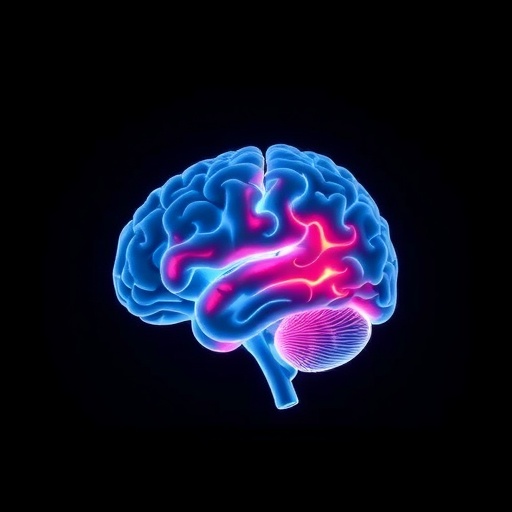A groundbreaking study from researchers at the University of California, Irvine’s Center for the Neurobiology of Learning and Memory has unveiled a novel perspective on how the aging process reshapes the human brain. Moving beyond traditional research that predominantly quantifies brain tissue loss in isolated regions, this study pioneers an innovative analytic approach focusing on the dynamic spatial geometry of the entire brain throughout adulthood. Utilizing this method, the investigators decoded subtle but significant morphological transformations that correlate tightly with cognitive decline, suggesting that the brain’s shape itself may serve as a sensitive biomarker for its overall health and function.
The research team embarked on an extensive examination of more than 2,600 neuroimaging scans from adult participants aged between 30 and 97 years. This comprehensive dataset allowed them to systematically map age-dependent shifts in brain topology rather than merely measuring volumetric reductions. Remarkably, they identified that the inferior (lower) and anterior (front) brain regions underwent expansion, while the superior (upper) and posterior (back) areas contracted. These shape modifications were not uniform but exhibited pronounced asymmetry in individuals exhibiting diminished cognitive abilities, such as impaired reasoning and memory. These correlations provide compelling evidence linking mechanical brain deformation with functional neurodegeneration.
Stepwise geometric alterations elucidated by this study reflect broader biological phenomena underpinning brain aging. One of the most compelling findings is the localized compression of posterior brain regions, phenomena hypothesized to exert physical pressure on crucial neural hubs. Notably, the entorhinal cortex—a small but pivotal structure within the medial temporal lobe implicated in memory consolidation—appears especially vulnerable. This region bears early accumulations of tau proteins, pathogenic agents heavily implicated in Alzheimer’s disease. The physical displacement of the entorhinal cortex closer to the rigid base of the skull suggests that mechanical and gravitational forces may significantly contribute to Alzheimer’s pathogenesis, an insight that broadens existing disease models which focus predominantly on molecular cascades.
“This discovery is a paradigm shift in understanding brain aging,” said Dr. Niels Janssen, senior author and professor at Universidad de La Laguna, also a visiting scholar at UCI’s CNLM. “Our data emphasize that it is not just how much brain tissue is lost, but how the overall brain geometry is remodeled systematically over time, fundamentally reshaping our view of neurodegenerative vulnerability.” Importantly, these shape biomarkers were independently validated in two separate datasets, reinforcing their reproducibility and robustness.
The mechanistic link between brain shape distortion and cognitive decline raises profound questions about the interplay of mechanical forces, tissue stress, and neurodegeneration. Dr. Michael Yassa, director of the CNLM and co-author, elaborates, “As the aging brain subtly shifts, it may increasingly pinch the fragile entorhinal cortex against the inflexible cranial base, potentially fostering an environment conducive to early pathological protein aggregation and neuronal loss.” This mechanical hypothesis introduces an underexplored dimension to Alzheimer’s research, advocating for multidisciplinary inquiries combining neuroanatomy, biomechanics, and molecular neuroscience.
The implications of this work extend well beyond academic curiosity. Geometric analysis of brain morphology could pioneer new avenues for early dementia risk identification. Current diagnostic modalities largely detect pathology after considerable cognitive impairment occurs, often relying on volumetric brain atrophy or molecular imaging techniques. In contrast, shape-based metrics derived from standard brain imaging could serve as non-invasive, accessible, and early indicators of neurodegenerative risk, potentially enabling interventions during preclinical stages when therapies might be most effective.
Beyond the entorhinal cortex, the observed macroscopic alterations in brain regions influence networks underlying memory, reasoning, and executive function. The flattening and inward contraction of posterior structures corresponded robustly with poorer performance on reasoning tasks among older adults. Thus, the spatial reconfiguration of the brain does not merely reflect passive aging but appears intricately linked to functional cognitive outcomes, highlighting the integral relationship between form and function in the human brain.
This pioneering work benefits from an international collaboration between UCI and Universidad de La Laguna, exemplifying how scientific progress is accelerated by cross-border partnerships. The multidisciplinary team integrated expertise in neuroimaging, computational analysis, aging neuroscience, and cognitive assessment, enabling comprehensive synthesis of complex, large-scale data into novel biological insights. The study underscores the critical importance of combining technical innovation with collaborative scholarship to address one of the most pressing public health challenges: dementia and neurodegeneration.
Looking ahead, the team is optimistic that the geometric approach could inspire new diagnostic and therapeutic strategies. By charting how architectural brain changes unfold before symptoms emerge, researchers can better stratify individuals by risk and tailor interventions more precisely. Further research will focus on elucidating the molecular and biomechanical underpinnings of these shape changes, potentially revealing modifiable factors that could mitigate or delay cognitive decline.
The study, published in the prestigious journal Nature Communications, was funded by the National Institute on Aging. It represents a significant leap in our understanding of brain aging, emphasizing that morphology—and not merely volume loss—should be considered a fundamental metric in neuroscience research. As Dr. Yassa poignantly concludes, “The answers to Alzheimer’s and other neurodegenerative diseases may be hiding in plain sight—in the very shape of the brain.”
In a landscape dominated by attempts to decode the molecular intricacies of dementia, this research invites a fresh vantage point that integrates structural brain dynamics with disease vulnerability. The findings call for renewed attention toward biomechanical and geometric factors and open exciting possibilities for innovative diagnostic tools that could transform clinical practice. Through such integrative science, we move closer to unraveling the complexity of brain aging and developing effective strategies to preserve cognitive health in our aging populations.
Subject of Research: Brain geometry changes related to aging and cognitive decline
Article Title: Age-related constraints on the spatial geometry of the brain
News Publication Date: October 1, 2025
Web References:
- Study article in Nature Communications: https://rdcu.be/eIKAu
- Larger research effort: http://beacon.bio.uci.edu/
- UC Irvine website: http://www.uci.edu
- UC Irvine News: http://news.uci.edu/
- Media Resources: https://news.uci.edu/media-resources/
References: Published article in Nature Communications, supported by National Institute on Aging
Keywords: Health and medicine, brain aging, neurodegeneration, Alzheimer’s disease, entorhinal cortex, brain morphology, cognitive decline




